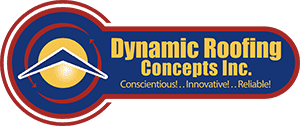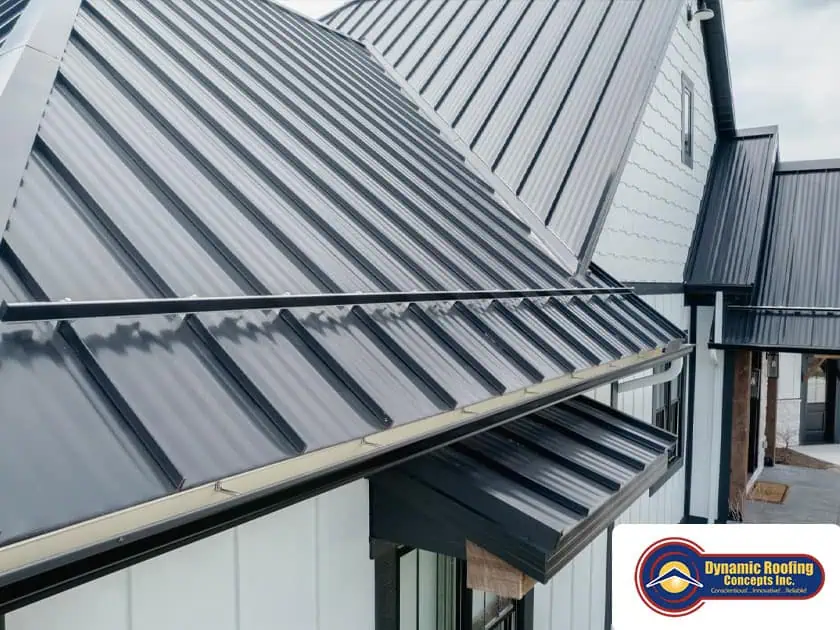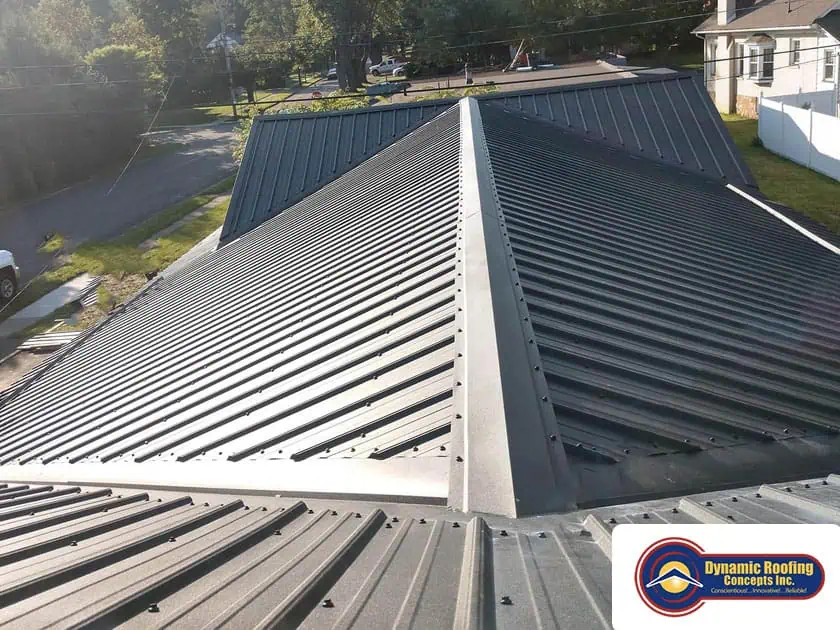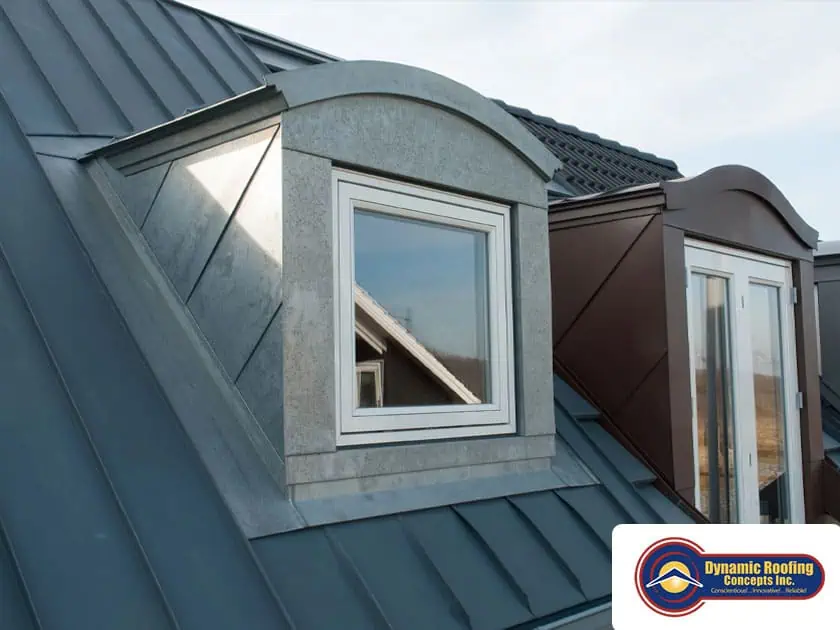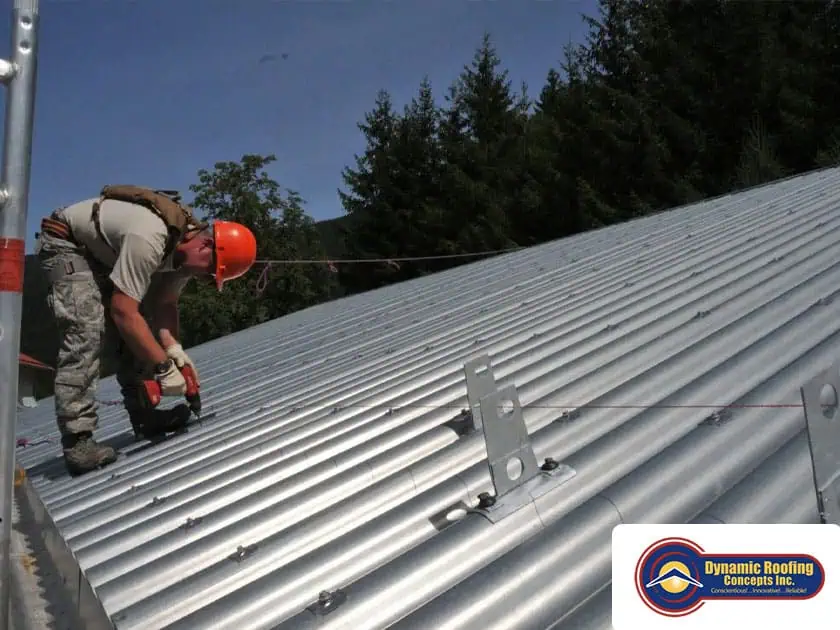

Share On:
Yes, you can install metal roofing directly over shingles. Still, you should consider several factors and potential drawbacks before proceeding with this installation method.
While installing metal roofing over shingles is technically possible, homeowners should carefully consider the structural integrity of their existing roof, local building codes, and potential long-term issues. Roofing experts highly recommend consulting a professional roofing contractor to assess your situation and ensure all installation guidelines are followed.
Advantages of Installing Metal Roofing Over Shingles
- Cost-Effective: Installing metal roofing over shingles can save on labor and disposal costs since you don't have to remove the existing shingles.
- Time-Saving: The installation process is generally quicker because the existing shingle layer is left in place.
- Additional Insulation: The existing shingles can provide extra insulation, potentially improving your home's energy efficiency.
- Durability: Metal roofs are known for their durability and ability to withstand severe weather conditions, which can extend the lifespan of your roof.
Disadvantages and Considerations
- Weight Concerns: The additional weight of the metal roof may require structural assessments to ensure your home can support it.
- Trapped Moisture: There is a risk of moisture becoming trapped between the shingle and metal layers, which can lead to mold, rot, and structural issues if not properly ventilated.
- Underlying Damage: Existing damage to shingles might go unnoticed, gradually worsening under the new metal roofing.
- Building Codes and Warranties: You should check local building codes and manufacturer warranties, as installing metal over shingles may not be allowed or could void warranties.
- Installation Quality: Proper installation is crucial; incorrect methods can lead to issues like improper water drainage or inadequate securing of the metal panels.
Installation Methods
- Direct Installation: Metal panels can be installed directly over the shingles, using an underlayment for additional protection against moisture.
- Using Battens: Installing battens (or purlins) over the shingles before laying the metal panels can help create a gap for ventilation, reduce the risk of moisture problems, and provide a more even surface for the metal roof.
What is Metal Roofing?
Before you begin installing metal roofing over shingles, it's important to understand what metal roofing involves and why it's a valuable choice. Metal roofing isn't a one-size-fits-all situation. You can compare and choose from various metal types, including aluminum, steel, copper, and zinc. Each has its advantages and disadvantages.
For instance, while aluminum is lightweight and corrosion-resistant, steel is renowned for its strength and durability. Copper and zinc, on the other hand, offer unique aesthetic appeal but can be pricier.
Metal roofing isn't just about functionality; it's also about enhancing your home's curb appeal. With many styles, colors, and finishes available, you can tailor your roof to complement your home's exterior perfectly.
Whether you prefer the sleek, modern look of standing seam metal roofs or the classic, timeless charm of metal shingles that mimic wood or slate, there's a style for every taste.
Don't just think about the practical aspects of metal roofing. Consider the visual impact as well. After all, a roof isn't just a cover over your head; it's also a statement about your home.
Benefits of Metal Over Shingles
You might wonder why you should consider metal over shingles. There are many benefits, including durability, cost-effectiveness over time, and enhanced energy efficiency.
Durability of Metal Roofing
Metal roofing typically outlasts its shingle counterparts, providing a durable, long-lasting option for your home. It's a choice that combines style, longevity, and eco-friendliness. With metal's recyclability and corrosion resistance, you're investing in a roof that maintains its quality and appearance for years.
Consider these advantages:
- Metal roofs can last 40-70 years, compared to asphalt shingle roofs, which only last 15-30 years.
- They're resistant to corrosion, fire, and insect damage.
- Metal is 100% recyclable, reducing landfill waste.
- Snow slides off easily, preventing build-up and potential collapse.
- It's lightweight and can be installed on top of existing roofs, saving removal and disposal costs.
Cost-Effectiveness Over Time
Despite the initial investment, opting for a metal roof over shingles can greatly reduce your long-term expenses. You'll appreciate the cost-effectiveness over time as it requires less maintenance and is incredibly durable. Plus, the resale value increase of your property due to a metal roof is remarkable! Let's not forget the recycling possibilities, which add to its environmentally friendly nature.
| Cost Factors | Shingle Roof | Metal Roof |
| Initial Cost | Lower | Higher |
| Maintenance | More Frequent | Minimal |
| Durability | Less | More |
| Resale Value Increase | Low | High |
| Recycling Possibilities | Limited | High |
Enhanced Energy Efficiency
Switching to a metal roof over shingles can greatly enhance your home's energy efficiency. Metal roofs' reflective coatings can deflect solar heat instead of absorbing it, reducing cooling costs in hot weather. Moreover, metal roofing opens up possibilities for solar integration.
Here are some key benefits:
- Reflective Coatings: They minimize heat absorption, keeping your home cooler.
- Solar Integration: Metal roofs can host solar panels more efficiently than shingle roofs.
- Heat Conduction: Metal roofs conduct heat quickly, reducing heat build-up.
- Insulation: In winter, metal roofs can better insulate your home, saving on heating costs.
- Durability: Metal roofs last longer, making them a cost-effective choice for long-term energy efficiency.
Metal Roofing Installation Process
Below, we detail the key steps for installing a metal roof over shingles.
Assessing Your Current Roof
To evaluate your current roof, you must determine its overall condition and identify any potential issues that may affect the metal roofing installation. Effective roof inspection techniques are essential to assess the state of your shingles and underlying structures. Look for signs of wear and damage, such as curling, blistering, or missing shingles, as well as water stains, which could indicate leaks.
Next, contemplate a shingle lifespan analysis. If your shingles are nearing the end of their typical lifespan - usually around 20-25 years for asphalt shingles - it's a good time to consider installing a metal roof. Even if they appear in decent shape, underlying damage or wear may not be visible to the untrained eye.
Necessary Materials and Tools
Ensure you have the necessary tools and materials:
- Tools: Sturdy ladder, metal shears, roofing hammer, chalk line, tape measure, drills, and safety gear (helmet, gloves, slip-resistant shoes).
- Materials: Roofing panels, screws, closure strips, and underlayment.
Gearing up with the right tools and materials is important in installing a metal roof over existing shingles. You'll need to ensure you have a sturdy ladder, metal shears, a roofing hammer, a chalk line, a tape measure, and drills with appropriate bits. You will also need to have the roofing panels, screws, and closure strips on hand.
Remember, safety precautions shouldn't be overlooked. Always wear a safety helmet, gloves, and slip-resistant shoes. If you'll be working at heights, use a harness. Remember to take breaks and stay hydrated, especially in hot weather.
Tool maintenance is equally significant. Keep your tools clean and properly stored to extend their lifespan and ensure they're safe. Periodically check your tools for damage and fix any issues promptly. Sharp tools make your job easier and reduce the risk of accidents.
Finally, have a plan for waste disposal. During the installation, you'll generate considerable scrap metal and shingle waste – a skip bin or similar waste container will be invaluable.
Preparing the Shingle Roof
- Conduct a thorough roof inspection.
- Repair any damaged or rotting sections.
- Clean the roof surface meticulously.
- Ensure all nails or screws are removed or hammered down.
Once you've gathered all your tools and materials, it's crucial that you correctly prepare your existing shingle roof for the metal overlay. This process is more than just removing shingles; it's about ensuring that your roof is in the best possible condition before installing the new metal roofing.
To prepare your roof, there are several steps you need to follow:
First, conduct a thorough roof inspection. This will help you identify structural issues that may interfere with the metal roofing installation.
If you find any damaged or rotting sections during your roof inspection, it's important to repair these damaged areas before proceeding.
After repair, clean the roof surface meticulously. Any debris left on your roof can cause problems down the line.
Lastly, check for any nails or screws sticking out from the roof surface. These can damage the new metal roof, so ensure they're either removed or hammered down.
Installing the Underlayment
- Choose between synthetic underlayment for durability and water resistance or felt for affordability and ease of installation.
- Install the underlayment horizontally from the eave towards the ridge, securing it with nails or staples every 12 inches. Overlap each row by at least two inches.
After preparing your roof, you can install the underlayment, a vital component that helps protect your home from water infiltration and wind damage. Underlayment selection is important in this phase, as the quality and type of underlayment can greatly affect the longevity and durability of your new metal roof.
Consider using a synthetic underlayment. Synthetic underlayments are known for their water resistance and durability. It might cost more, but this extra protection makes it a valuable investment. Alternatively, you could opt for felt, a more affordable underlayment that is easier to install.
Speaking of installation techniques, start by rolling the underlayment horizontally from the eave towards the ridge. Secure it with roofing nails or staples every 12 inches apart. Overlap each subsequent row by at least two inches to ensure water doesn't seep through. Remember, the smoother the underlayment, the better your metal roofing will look and perform.
Do not rush this process. Take your time to ensure the underlayment is properly installed. Any mistakes can lead to serious issues in the future. A well-installed underlayment sets the foundation for a successful metal roofing installation.
Installing the Metal Roof
Once the underlayment has been installed, you can move on to the main event—the metal roofing installation.
You'll start with some basic preparations; then, we'll walk you through the process of installing the roof over the shingles.
It's simpler than you might think, so let's get started.
Preparing for Installation
Before beginning the installation process, you'll need to:
- Clear the workspace of any debris
- Check the roof's structural integrity
- Gather your metal roofing materials and tools
- Ensure all safety gear is acquired and in good condition
This prep work will protect you and your team for a smoother installation process.
Now, you're set to move on to the next phase: the roofing over shingles process.
Roofing Over Shingles Process
With your workspace and materials ready, you can install the metal roofing over the existing shingles. Remember safety precautions, including using appropriate protective gear (PPE) and a stable ladder.
| Steps | Description | Important Notes |
| Measurement | Measure your roof to determine the amount of metal roofing needed. | Safety precautions: Use a sturdy ladder. |
| Installation | Install the metal roofing panels over the shingles. | No need for shingle disposal methods. |
| Inspection | Check the installed roofing for any loose areas or gaps. | Ensure proper sealing to avoid leaks. |
Dealing With Roof Protrusions
- Identify all roof protrusions and use appropriate sealing methods and flashing techniques to ensure a watertight seal around the base of the protrusions.
When installing metal roofing over shingles, you'll inevitably encounter a few protrusions, such as vents or chimneys, that you'll need to deal with carefully. These structures can be tricky, but with the right protrusion sealing and flashing techniques, you can handle them like a pro.
Identify all roof protrusions. Once identified, use appropriate sealing methods to ensure no water gets underneath your new metal roof. This is where protrusion sealing comes in. It's a process that involves using a special sealant to guarantee a watertight seal around the base of the protrusion.
Next, you'll need to master various flashing techniques. Flashing is a thin piece of impervious material installed to prevent the passage of water into a structure from an angle or joint. It's commonly used around protrusions to redirect water away from these areas.
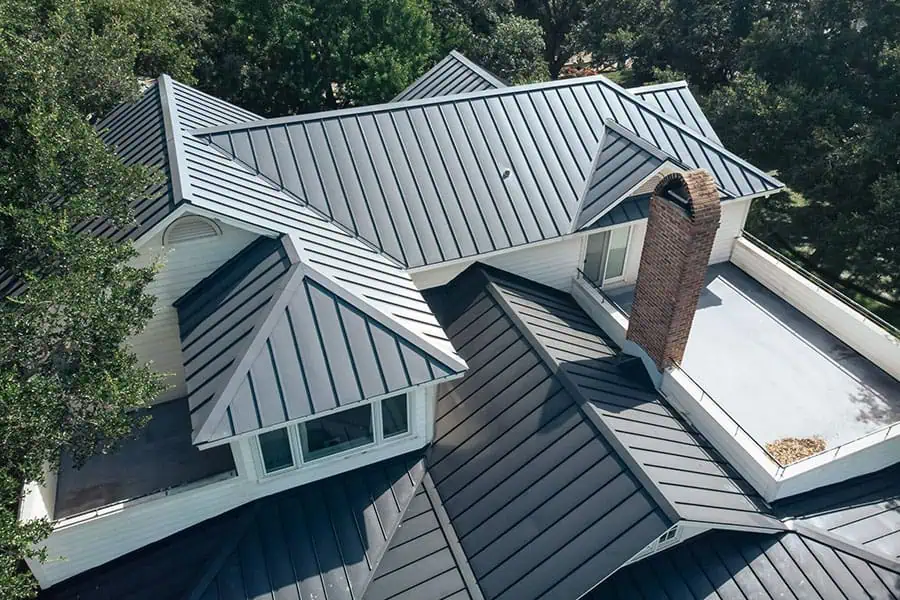
Potential Challenges and Solutions
While installing metal roofing over shingles might present some challenges, practical solutions exist. One of the first challenges could be the impact of local regulations. Depending on your local building codes, you may be required to install a specific type of underlayment before installing a metal roof over a shingle roof. Research your local building codes or consult a local contractor to ensure compliance.
Another hurdle could be disposal considerations. You'll have waste materials from the installation process and need to figure out how and where to dispose of them properly. Consider renting a dumpster or hiring a waste removal service to handle this.
Getting the most out of your metal roof also requires proper preparation and installation of the new metal roof over the old shingle roof. Improper installation can lead to decking issues and
Here's a quick breakdown of some potential challenges and solutions:
| Challenge | Solution |
| Local regulations impact | Research local building codes or consult a contractor. |
| Disposal considerations | Rent a dumpster or hire a waste removal service. |
| Installation errors | Hire a professional or carefully follow installation guides. |
Dynamic Roofing Concepts Can Help
While it is possible to install a metal roof over shingles on your own, there are many reasons you might consider hiring a roofing contractor instead. For help deciding if installing a metal roof over your old shingle roof is the right choice for your home, contact us at (813) 657-7663 or visit us online at dynamicroofingconcepts.com for a free, no-obligation estimate.
Frequently Asked Questions About Installing A Metal Roof Over Shingles
Do you need underlayment when installing a metal roof over shingles?
Yes, an underlayment should be used when installing metal roofs over shingles. Underlayment acts as a moisture barrier, preventing water from infiltrating the roof's structure and providing additional insulation. It is particularly advisable in areas prone to heavy rainfall or snow, as it will protect your roof from moisture damage over time. The underlayment should be installed according to the manufacturer's guidelines and secured to the roof deck.
Can you put a metal roof over shingles without furring strips?
Furring strips are wooden slats or other materials attached to the roof to level it and create a space between the old and new roofing layers. This air pocket under the roof helps improve ventilation and prevents moisture buildup. Installing a metal roof over shingles without furring strips is not recommended. The metal's thermal expansion and contraction can rub against the shingle granules, corroding the metal from the underside. Additionally, the gaps introduced by furring strips allow for air ventilation, which can reduce moisture. Typically, building codes require furring out the roof before installing metal roofing over shingles.
Is it better to remove shingles before installing a metal roof?
Keeping the existing shingles can be a more cost-effective and time-saving option, but removing them ensures a proper surface and compliance with building codes and reduces the risk of moisture-related problems. The decision should be based on the specific circumstances, local regulations, and the advice of a professional roofing contractor.
| Factors | Keeping Shingles | Removing Shingles |
| Cost-Effectiveness | Saves on labor and disposal costs | Higher upfront costs |
| Environmental Impact | Reduces waste sent to landfills | May generate more waste |
| Insulation | Existing shingles provide additional insulation | No additional insulation from shingles |
| Installation Time | Faster installation process | Longer installation time |
| Building Codes | May not be allowed in some areas | Ensures compliance with local regulations |
| Appearance and Surface Quality | Existing shingles may create uneven surface | Flat, even surface for metal roof |
| Moisture Concerns | Risk of trapped moisture between layers | Reduces risk of moisture-related issues |
